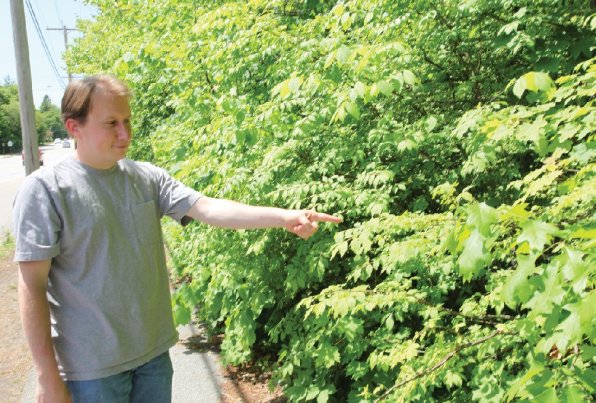Concord is a dangerous place. If you don't believe us, take a peek out your back window. Look close enough and you're likely to discover a menacing bunch of rugged ruffians threatening your precious petunias, strong-armed bullies choking your favorite oak tree and hungry hooligans stealing water from your soil. The scariest part about these monsters? Many are hidden in plain sight.
Invasive plant species pose a real threat to existing natural habitats wherever they grow. They're highly aggressive and destructive, competing for the space and resources of existing landscapes. While there are dozens of types of invasives that have made their homes in New Hampshire – including insects, aquatic plants and fungal species that primarily affect trees – in this article, we focused solely on soil-bound invasives that are most prevalent in Concord.
To better understand what we were dealing with, we recruited Pete Bowman, wildlife expert with the state's Department of Resources and Economic Development and city forester Ron Klemarczyk, (who, full disclosure, is this writer's stepdad). They agreed to help us explore the darker sides of the city's forests.
It was a dangerous mission, make no mistake. We bushwhacked through black fly-infested woods and braved poison ivy patches the size of small ponds.
On a sunny day last week, we ventured to the conservation center behind the Society for the Protection of New Hampshire Forests in East Concord. The area, a popular spot with access to walking trails along the river, is a haven for invasive species, including winged euonymos, honeysuckle, autumn olive, multiflora rose, and Japanese barberry.
Still, we were ready for a nice, relaxing stroll.
“Just so you know, it's kind of a horror show back here,” Pete warned us as we approached the path. “For people who know their plants, walking in the woods is kind of a bummer.”
We weren't too concerned. After all, how bad could a few plants be?
While skipping merrily across the paths and dancing to bird songs, Pete stopped us to point out a tall plot of Japanese knotweed making its way onto the trail. The plant looked nice enough, sort of like bamboo. Pete warned us to resist its charm: The knotweed, which is prevalent along riverbeds, poses a significant threat to other plants. It can survive severe floods and rapidly overtakes scoured shores and islands, he said. Once established, it's extremely persistent and can grow over 10 feet in height.
Farther on, we encountered lots of oriental bittersweet, a nasty vine with a penchant for wrapping itself around trees like a snake and pulling them to the ground. The bittersweet, first introduced as an ornamental fixture to gardens in the 1700s, can be a costly problem to deal with.
Along the edges of Penacook Lake on Little Pond Road, we visited a shady pine tree stand being devoured by bittersweet. The trees, which could have been harvested and sold to buy conservation land for the city, are now worthless, Ron said.
After habitat loss, invasive species are considered the second largest contributor to the decline of biopersity in North America. A 2004 study from researchers at Cornell University estimated that environmental damages and losses caused by invasive species in the United States total $120 billion each year. That's a lot of green.
Invasive plants, our experts told us, spread in a variety of ways. Birds eat their seeds (essentially providing them with empty calories because they hold little nutritional value) and spread them in their droppings. Seeds are also carried by wind and water and frequently establish themselves in areas of disturbed soil (along riverbeds and new developments).
Human activities also contribute to the spread of invasives. Before a number of non-native plants were banned by the state in 2004, people regularly planted them in their own yards. (The garden of the historic Daniel Abbott house on Little Pond Road, Ron said, was “ground zero” for much of the bittersweet now plaguing the land around the reservoir.)
The Norway maple tree, which lines many Concord streets, was planted in large numbers during the '80s because isn't as susceptible to road salt damage. It was later learned that the dominant plant displaces native trees, shrubs and herbs.
Even the state Fish and Game Department, back in the '80s, jumped on the invasives bandwagon: At the time, Ron was employed by the state and charged with overseeing its nursery. Wanting to expand its shrubbery offerings, the state introduced a number of species to the nursery that later turned out to be invasive, Ron said.
“At the time, no one knew what these shrubs were capable of,” he said. “No one knew how hard they would be to get rid of, either.”
Blacklisted
Don’t let their sweet names fool you. The following plants are prohibited to sell in the state of New Hampshire:
Norway maple
Tree of heaven
Garlic mustard
Japanese barberry
European barberry
Oriental bittersweet
Spotted knapweed
Black swallow wort
Pale swallow wort
Autumn olive
Burning bush
Giant hogweed
Dame’s rocket
Water flag
Perennial pepperweed
Blunt-leaved privet
Showy bush honeysuckle
Japanese honeysuckle
Morrow’s honeysuckle
Tatarian honeysuckle
Japanese stilt grass
Japanese knotweed
Mile-a-minute vine
Bohemian knotweed
Common buckthorn
Glossy buckthorn
Multiflora rose
Source: Invasive Plant Atlas of New England









